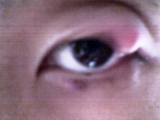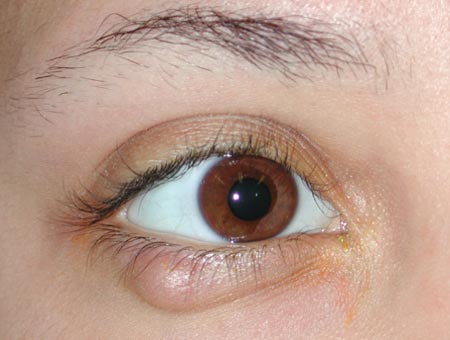Chalazion
| Chalazion | |
 | |
|---|---|
| Eyelid affected by Chalazion | |
| ICD-10 | H00.1 |
| ICD-9 | 373.2 |
| DiseasesDB | 6009 |
| MedlinePlus | 001006 |
| eMedicine | emerg/94 oph/243 |
|
WikiDoc Resources for Chalazion |
|
Articles |
|---|
|
Most recent articles on Chalazion |
|
Media |
|
Evidence Based Medicine |
|
Clinical Trials |
|
Ongoing Trials on Chalazion at Clinical Trials.gov Clinical Trials on Chalazion at Google
|
|
Guidelines / Policies / Govt |
|
US National Guidelines Clearinghouse on Chalazion
|
|
Books |
|
News |
|
Commentary |
|
Definitions |
|
Patient Resources / Community |
|
Patient resources on Chalazion Discussion groups on Chalazion Directions to Hospitals Treating Chalazion Risk calculators and risk factors for Chalazion
|
|
Healthcare Provider Resources |
|
Causes & Risk Factors for Chalazion |
|
Continuing Medical Education (CME) |
|
International |
|
|
|
Business |
|
Experimental / Informatics |
Please Take Over This Page and Apply to be Editor-In-Chief for this topic: There can be one or more than one Editor-In-Chief. You may also apply to be an Associate Editor-In-Chief of one of the subtopics below. Please mail us [1] to indicate your interest in serving either as an Editor-In-Chief of the entire topic or as an Associate Editor-In-Chief for a subtopic. Please be sure to attach your CV and or biographical sketch.
Overview
A chalazion Template:IPA (plural chalazia Template:IPA), also known as a meibomian gland lipogranuloma, is a cyst in the eyelid that is caused by inflammation of a blocked meibomian gland, usually on the upper eyelid. Chalazions differ from styes (hordeolums) in that they are usually painless apart from the tenderness caused when they swell up. A chalazion may eventually disappear on its own after a few months, though more often than not, some treatment is necessary.
Diagnosis
Signs and symptoms
- Swelling on the eyelid
- Eyelid tenderness
- Sensitivity to light
- Increased tearing
Physical Examination
Eyes

Treatment
The primary treatment is application of warm compresses for 10 to 20 minutes at least 4 times a day. This may soften the hardened oils blocking the duct and promote drainage and healing.
Topical antibiotic eye drops or ointment (eg chloramphenicol or fusidic acid) are sometimes used for the initial acute infection, but are otherwise of little value in treating a chalazion. Chalazia will often disappear without further treatment within a few months and virtually all will resorb within two years.[2]
If they continue to enlarge or fail to settle within a few months, then smaller lesions may be injected with a corticosteroid or larger one may be surgically removed using local anesthesia.[3][4] This is usually done from underneath the eyelid to avoid a scar on the skin. Rarely chalazia may reoccur and these will be biopsied to help rule out tumors.
Complications
A large chalazion can cause astigmatism due to pressure on the cornea. This will resolve with resolution of the chalazion.
Complications including, but not limited to hypopigmentation may occur with corticosteroid injection.
The presence of recurring chalazion in the same area sometimes leads to a consideration of sebaceous cell carcinoma.
The minor operation is quite painless, the eyelid is injected with a local anesthetic a clamp is put on the eyelid, then the eyelid is turned over and the chalazion is scraped out.
Prevention
Proper cleansing of the eyelid may prevent recurrences in people prone to chalazia. Cleaning the eyelash area with diluted baby shampoo will help reduce clogging of the ducts.[5]
See also
References
- J.B. Lippincott, ed. (1994). The Wills Eye Manual: Office and Emergency Room Diagnosis and Treatment of Eye Disease.
- ↑ http://picasaweb.google.com/mcmumbi/USMLEIIImages
- ↑ Chalazion Template:GPnotebook
- ↑ Khurana A, Ahluwalia B, Rajan C (1988). "Chalazion therapy. Intralesional steroids versus incision and curettage". Acta Ophthalmol (Copenh). 66 (3): 352–4. PMID 10994460.
- ↑ Jackson T, Beun L (2000). "A prospective study of cost, patient satisfaction, and outcome of treatment of chalazion by medical and nursing staff". Br J Ophthalmol. 84 (7): 782–5. PMID 10873994. — in which of those cases attending a District General Hospital, approximately one third of selected chalazia resolved within 3 months with conservative treatment, and surgical treatment was successful for 72%.
- ↑ (UK) Moorfields Eye Hospital. "Blepharitis — Lid Hygiene Advice For Patients" (DOC). — Patient information leaflet
External links
- William Charles Caccamise Sr. "A cache of photographs of various stages of the chalazion". EyeRounds.org.